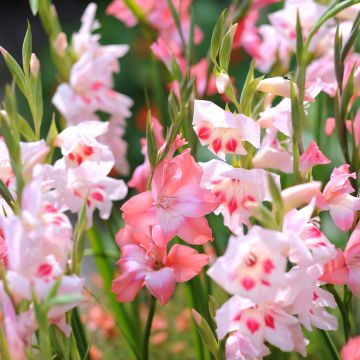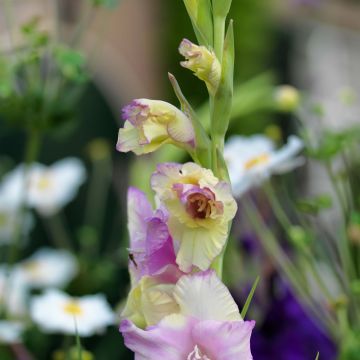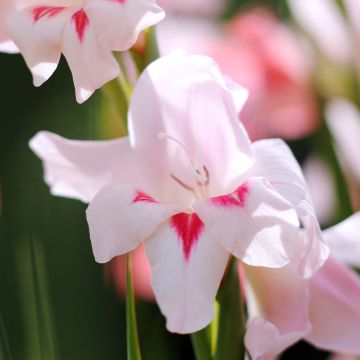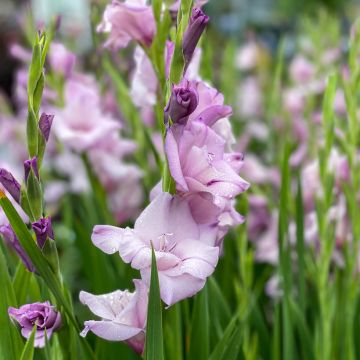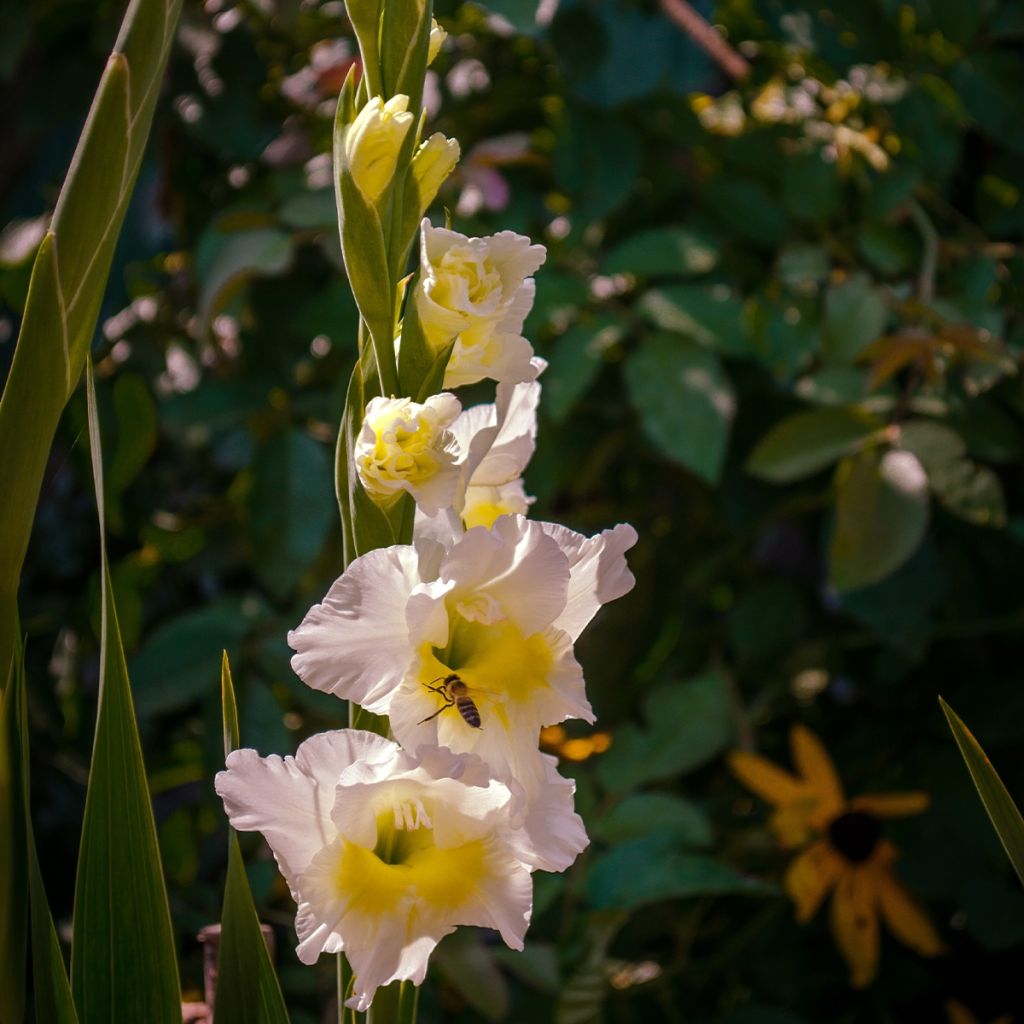

Glaïeul ou Gladiolus Break of Dawn
View more pictures
Hide images
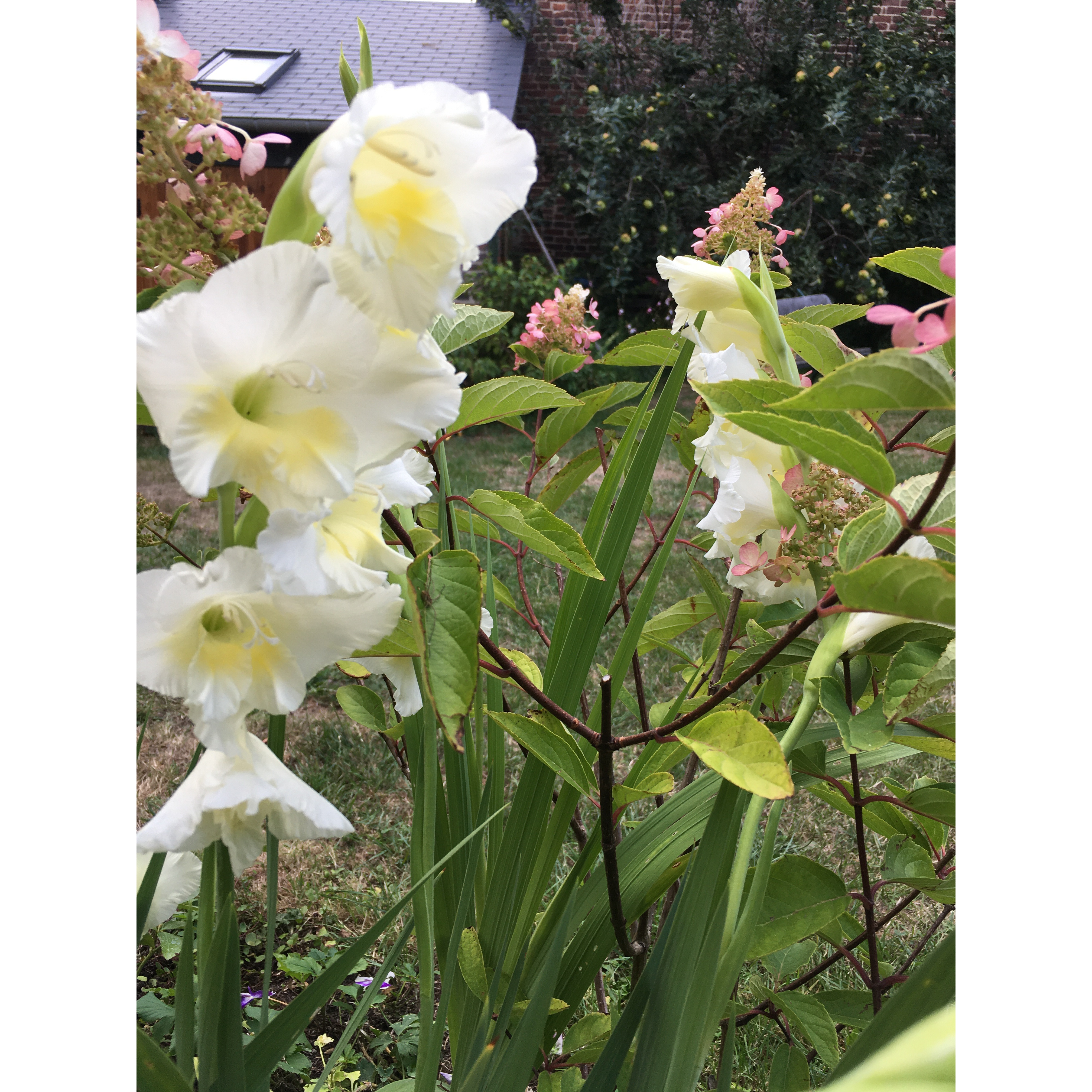
Danielle L.

Danielle L. • 14 FR
Gladiolus grandiflorus Break of Dawn - Sword Lily
Gladiolus x grandiflorus Break of Dawn
Large-Flowered Gladiolus, Sword Lily
Excellent!
Emmanuel , 17/09/2024
Special offer!
Receive a €20 voucher for any order over €90 (excluding delivery costs, credit notes, and plastic-free options)!
1- Add your favorite plants to your cart.
2- Once you have reached €90, confirm your order (you can even choose the delivery date!).
3- As soon as your order is shipped, you will receive an email containing your voucher code, valid for 3 months (90 days).
Your voucher is unique and can only be used once, for any order with a minimum value of €20, excluding delivery costs.
Can be combined with other current offers, non-divisible and non-refundable.
Why not try an alternative variety in stock?
View all →This plant carries a 6 months recovery warranty
More information
We guarantee the quality of our plants for a full growing cycle, and will replace at our expense any plant that fails to recover under normal climatic and planting conditions.

Would this plant suit my garden?
Set up your Plantfit profile →
Description
Gladiolus 'Break of Dawn', registered in 1975, is a variety of gladiolus whose shorter floral stems are filled with an abundance of flower buds. Its summer flowering is quite early for a gladiolus. It is composed of medium-sized florets with white petals and a pale-yellow throat. As bright as they are elegant, these floral spikes blend beautifully with the light foliage of fennels, grasses, and green blooms, both in flower beds and in bouquets.
The genus Gladiolus belongs to the Iridaceae family. Gladioli originate from Africa, Europe, and the Middle East. The most colourful gladiolus species come from South Africa. Cultivated gladioli are hybrids with large flowers, divided into 3 main groups: Grandiflorus (with large flowers), Primulinus (early), and Nanus (butterflies). 'Break of Dawn' is part of the Grandiflorus group. It is a perennial herbaceous plant with corms (globose bulbs) and wide sword-shaped leaves arranged in a fan shape. It forms a clump about 70cm (28in) tall when in bloom, depending on growing conditions. The leaves are topped by a spike-shaped inflorescence, with funnel-shaped flowers that are 9cm (4in) wide. They are arranged unilaterally, almost on the same side of the floral stem. They display two shades of white, speckled with pale-yellow at the throat and with a small green heart. The 6 tepals (or undifferentiated petals) are slightly undulated.
Gladioli and their colourful flower stalks are a symbol of the 1970s and somewhat formal floral arrangements. While they are irreplaceable in bouquets, their silhouette in gardens needs the presence of plants with lush foliage that will enhance their flowers. Plant them in groups in beds with salvias, small grasses, linarias, monardas, wallflowers, and forget-me-nots to create large colourful bouquets. They are regulars in cottage gardens. For bouquets, cut the flower stalks when the first floret starts to open. Plant them at intervals of two weeks from early spring until the end of June to have flowers in the house and garden all summer long.
Gladiolus gets its name from the shape of its sword-like leaves, derived from the Latin word gladius.
About botanical gladioli
Wild gladioli are far from the cultivated varieties with elaborate blooms. However, they are an interesting alternative for gardeners, and it is perfectly possible to welcome them in our gardens, as many of them originate from our temperate climates and are still very elegant.
The most common ones are Gladiolus byzantinus, with its pink-purple spring flowering, which naturalises itself, and Gladiolus x colvillei, which displays flowers in various colours that are usually marked with pink or red at the throat. Among the very hardy species that naturalise, there is Gladiolus communis from southern Europe, with pink flowers striped or speckled with white or red. Gladiolus illyricus, widespread from southern England to the Caucasus, forms superb spikes of magenta-violet flowers streaked with white. Gladiolus imbricatus has crimson-violet flowers with a very bright white spot highlighted with carmine purple.
Report an error about the product description
Gladiolus grandiflorus Break of Dawn - Sword Lily in pictures
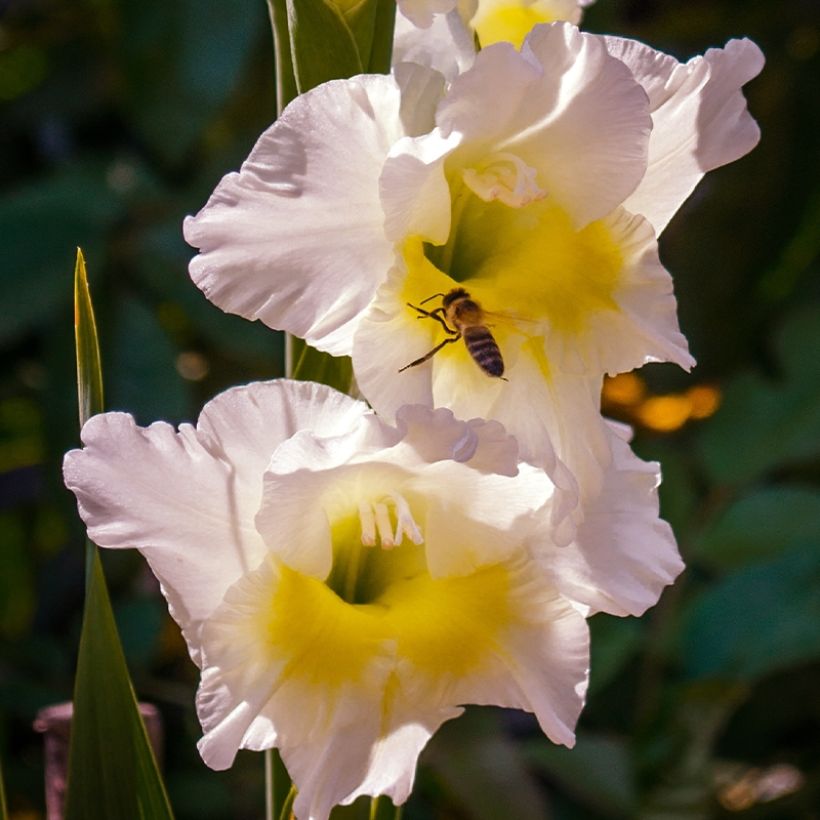

Plant habit
Flowering
Foliage
Botanical data
Gladiolus
x grandiflorus
Break of Dawn
Iridaceae
Large-Flowered Gladiolus, Sword Lily
Cultivar or hybrid
Other Gladioli
View all →Planting and care
Hybrid gladioli thrive in rich, fertile, well-drained, sandy soils. Plant them in full sun. Space the corms 10 to 15cm (4 to 6in) apart, covered with 10cm (4in) of soil. Avoid using manure to fertilise the soil as it promotes bulb rot. Gladioli are susceptible to frost, so they should be dug up when they have withered or immediately after the first frost. Cut the leaves and let them dry in a well-ventilated area for three weeks. Remove the old corms, store the new corms throughout winter in a cool place that is protected from frost. The cormlets will flower in two years. It is advisable not to plant gladiolus corms in the same spot for several years in a row. An annual rotation will yield better results. In mild climates, corms can be planted in September-October and left in the ground over winter without damage.
Planting period
Intended location
Care
-
, onOrder confirmed
Reply from on Promesse de fleurs
Haven't found what you were looking for?
Hardiness is the lowest winter temperature a plant can endure without suffering serious damage or even dying. However, hardiness is affected by location (a sheltered area, such as a patio), protection (winter cover) and soil type (hardiness is improved by well-drained soil).

Photo Sharing Terms & Conditions
In order to encourage gardeners to interact and share their experiences, Promesse de fleurs offers various media enabling content to be uploaded onto its Site - in particular via the ‘Photo sharing’ module.
The User agrees to refrain from:
- Posting any content that is illegal, prejudicial, insulting, racist, inciteful to hatred, revisionist, contrary to public decency, that infringes on privacy or on the privacy rights of third parties, in particular the publicity rights of persons and goods, intellectual property rights, or the right to privacy.
- Submitting content on behalf of a third party;
- Impersonate the identity of a third party and/or publish any personal information about a third party;
In general, the User undertakes to refrain from any unethical behaviour.
All Content (in particular text, comments, files, images, photos, videos, creative works, etc.), which may be subject to property or intellectual property rights, image or other private rights, shall remain the property of the User, subject to the limited rights granted by the terms of the licence granted by Promesse de fleurs as stated below. Users are at liberty to publish or not to publish such Content on the Site, notably via the ‘Photo Sharing’ facility, and accept that this Content shall be made public and freely accessible, notably on the Internet.
Users further acknowledge, undertake to have ,and guarantee that they hold all necessary rights and permissions to publish such material on the Site, in particular with regard to the legislation in force pertaining to any privacy, property, intellectual property, image, or contractual rights, or rights of any other nature. By publishing such Content on the Site, Users acknowledge accepting full liability as publishers of the Content within the meaning of the law, and grant Promesse de fleurs, free of charge, an inclusive, worldwide licence for the said Content for the entire duration of its publication, including all reproduction, representation, up/downloading, displaying, performing, transmission, and storage rights.
Users also grant permission for their name to be linked to the Content and accept that this link may not always be made available.
By engaging in posting material, Users consent to their Content becoming automatically accessible on the Internet, in particular on other sites and/or blogs and/or web pages of the Promesse de fleurs site, including in particular social pages and the Promesse de fleurs catalogue.
Users may secure the removal of entrusted content free of charge by issuing a simple request via our contact form.
The flowering period indicated on our website applies to countries and regions located in USDA zone 8 (France, the United Kingdom, Ireland, the Netherlands, etc.)
It will vary according to where you live:
- In zones 9 to 10 (Italy, Spain, Greece, etc.), flowering will occur about 2 to 4 weeks earlier.
- In zones 6 to 7 (Germany, Poland, Slovenia, and lower mountainous regions), flowering will be delayed by 2 to 3 weeks.
- In zone 5 (Central Europe, Scandinavia), blooming will be delayed by 3 to 5 weeks.
In temperate climates, pruning of spring-flowering shrubs (forsythia, spireas, etc.) should be done just after flowering.
Pruning of summer-flowering shrubs (Indian Lilac, Perovskia, etc.) can be done in winter or spring.
In cold regions as well as with frost-sensitive plants, avoid pruning too early when severe frosts may still occur.
The planting period indicated on our website applies to countries and regions located in USDA zone 8 (France, United Kingdom, Ireland, Netherlands).
It will vary according to where you live:
- In Mediterranean zones (Marseille, Madrid, Milan, etc.), autumn and winter are the best planting periods.
- In continental zones (Strasbourg, Munich, Vienna, etc.), delay planting by 2 to 3 weeks in spring and bring it forward by 2 to 4 weeks in autumn.
- In mountainous regions (the Alps, Pyrenees, Carpathians, etc.), it is best to plant in late spring (May-June) or late summer (August-September).
The harvesting period indicated on our website applies to countries and regions in USDA zone 8 (France, England, Ireland, the Netherlands).
In colder areas (Scandinavia, Poland, Austria...) fruit and vegetable harvests are likely to be delayed by 3-4 weeks.
In warmer areas (Italy, Spain, Greece, etc.), harvesting will probably take place earlier, depending on weather conditions.
The sowing periods indicated on our website apply to countries and regions within USDA Zone 8 (France, UK, Ireland, Netherlands).
In colder areas (Scandinavia, Poland, Austria...), delay any outdoor sowing by 3-4 weeks, or sow under glass.
In warmer climes (Italy, Spain, Greece, etc.), bring outdoor sowing forward by a few weeks.































